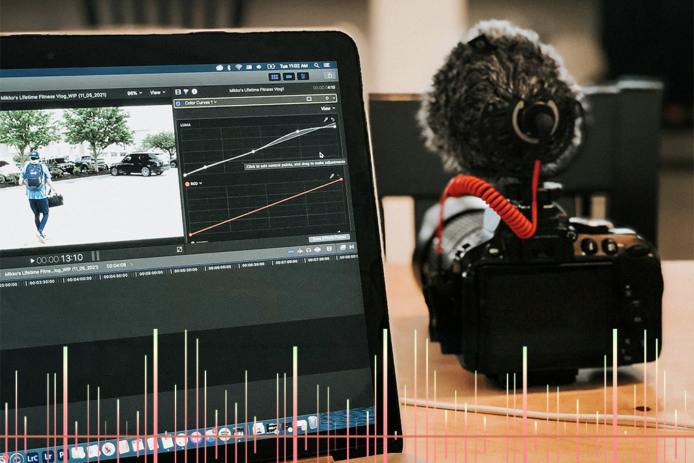Subtitles are essential for video accessibility, allowing a wider audience to enjoy content, including those who are hard of hearing or non-native speakers. However, different subtitle formats can cause compatibility issues in video production.
Two common formats are SUP (Subtitle Picture) and SRT (SubRip Subtitle). SUP subtitles are widely used for DVDs and Blu-Ray content but come with limitations like restricted editability and compatibility. In contrast, SRT files are more flexible, easy to edit, and compatible with most video players and platforms.
If you want to make your content more accessible, converting .SUP to .SRT is a crucial step. This conversion improves usability, allows customization, and ensures seamless integration with various media players. While it may seem complex, the process is straightforward. Here’s how you can convert SUP to SRT efficiently and enhance your video content for a broader audience.
Key Takeaways
- SUP and SRT are both common file types used for subtitles in video content.
- While SUP is popular for DVD and Blu-Ray due to its high optical quality, SUP files pose many challenges with editing, customization, accessibility, costs, and more.
- Many people need to convert SUP into much more convenient SRT files, which can be done using an advanced SUP to SRT converter online.
How to Convert SUP to SRT for Proper Playback With SubtitleEdit
SubtitleEdit is one of the softwares that is capable of converting SUP to SRT using OCR.
- Download and Install Subtitle Edit
- Visit the official Subtitle Edit website
- Download and install the latest version of Subtitle Edit.
- Load the SUP File
- Launch Subtitle Edit after installation.
- Go to `File` in the menu bar.
- Select `Open` (or press Ctrl+O).
- Navigate to the folder containing your SUP file.
- Select the SUP file and click `Open`.
- Converting SUP to SRT
- Once the SUP file is loaded, go to the `OCR` menu.
- Choose `OCR (image-based subtitles)` to start the Optical Character Recognition process.
- If prompted, select the appropriate language for the subtitles.
- Correcting OCR Errors
- The OCR process will convert images of text into editable text but may have errors.
- Carefully go through the converted text and correct any mistakes.
- Saving as SRT
- Select `Save as`.
- Choose `SubRip (*.srt)` as the file format.
- Name your file and choose a location to save it.
- Click `Save`.
This process uses OCR technology, which is not perfect. Be prepared to spend some time correcting errors, especially with unusual fonts or low-quality SUP files.
Looking to convert other files to SRT? Check out some of our guides below:
How is OCR Used to Convert the SUP File to SRT?
Conversion from SUP to SRT online is done by using an OCR. This is a tool that can scan an image to recognize, analyze, and generate text written in an image.
OCR software allows the bitmap images or the image-based SUP files to be converted into text-based SRT files, ultimately making them easier to work with, along with all of the other advantages discussed above.
OCR SUP to SRT conversion software works by first cleaning up the image so that the text is easy to recognize accurately. The software removes any noise that may prevent it from properly identifying the text within the image. The OCR software then carefully analyzes the image.
When the OCR conversion is complete, the result is a text-based SRT subtitle file.
Tips Before You Convert SUP to SRT Online
Let’s go over some valuable tips to make the process of converting SUP to SRT files online as easy and successful as possible.
- Ensure that the SUP files are of good quality. Poor image resolution may lead to errors during the OCR process. If you expect the conversion results to be high-quality, the original files need to be high-quality as well.
- Always keep a backup of your original SUP files. In case there is an error during the conversion process, you’ll still have the originals.
- The number one tip to follow is to choose an accurate and effective online converter. The right tool will produce reliable results.
- After the conversion is complete, check the time codes to ensure they are accurate, or else the subtitles may not be properly synchronized with the video content.
Methods to Convert SUP to SRT
There are several ways to convert SUP files into SRT format, each offering different levels of accuracy, speed, and ease of use. Below are the most effective methods, including Sonix, a leading AI-powered transcription platform.
1. Using Sonix for SUP to SRT Conversion
Sonix is an AI-powered speech-to-text tool that generates transcriptions that can then be formatted as subtitles. While our platform does not directly convert SUP to SRT, it can be used to create accurate subtitle files from audio content and format them in a range of options including SRT.

To generate subtitles using Sonix, upload your video or audio file, let the AI transcribe the speech, and then format the transcript into subtitles before exporting it as an SRT file.
2. Using Subtitle Edit (Best for Manual Adjustments)
Subtitle Edit is a free desktop software that provides OCR-powered conversion for SUP files. Users can import the SUP file, manually verify OCR results, and export an accurate SRT file. This method allows for fine-tuned adjustments and is ideal for those needing precise editing.
3. Using Online Subtitle Converters (Quick but Less Accurate)
Web-based tools like Subtitle Tools offer a fast solution to convert SUP to SRT without requiring downloads. However, OCR accuracy varies, and some large files may not be supported.
4. Using FFmpeg (For Advanced Users)
FFmpeg is a command-line tool that extracts subtitles from video files, including SUP. However, since it does not support OCR, users must process the extracted subtitles separately. This method is best for tech-savvy users who prefer script-based solutions.
Comparison of SUP to SRT Conversion Methods
| Method | Ease of Use | Accuracy | Best For | Free/Paid |
| Sonix | Extremely easy | 99% accuracy | AI-powered automated conversion | Paid, 30-minute free trial available — no credit card required |
| Subtitle Edit | Relatively easy, required software download | Reasonably accurate | Manual editing and fine-tuning | Free |
| Online Converters | Extremely easy | Quality can be mediocre at times | Quick conversions for small files | Free |
| FFmpeg | Extremely technical, required some coding knowledge | High | Command-line processing | Free |
What is an SUP File?
SUP (Subtitle Picture) files are image-based subtitles used in Blu-Ray and DVD formats, overlaying text as images onto video content. This format supports high-definition subtitles, allowing for customizable fonts, colors, and positions while ensuring crisp readability.
However, SUP files require special software to create and edit, making the process complex and time-consuming. Synchronization can also be challenging since each subtitle frame is timestamped to match video playback.
Despite their benefits, SUP subtitles lack flexibility and compatibility with many platforms. Converting SUP to SRT simplifies editing, improves accessibility, and ensures smoother integration with various media players.
What is an SRT File?
SRT (SubRip Subtitle) files are text-based subtitles, widely used due to their simplicity and compatibility. Unlike image-based SUP files, SRT files store subtitles as plain text, making them easy to edit and widely supported across video players and platforms.
Each SRT entry includes a number, a timecode for synchronization, subtitle text, and a blank line to separate entries. While SRT doesn’t support text formatting (e.g., colors or fonts), its plain-text format allows quick edits using any text editor.
SRT files are also ideal for translations, enabling seamless adaptation into different languages for broader accessibility. Their versatility and ease of use make them the go-to subtitle format for most video content.
Comparing SUP vs .SRT Subtitle Files
Here’s a table to summarize the main differences between SUP and SRT files.
| SUP (Subtitle Picture) | SRT (SubRib Text) | |
| File Format | Bitmap image-based subtitle format. | Plain text format. |
| Compatibility | Commonly used with DVDs, Blu-ray. | Widely supported by most video players and editing software. |
| Editing | Requires specialized software to edit; more complex due to image-based nature. | Easily editable with any text editor. |
| Customization | High level of customization for font, color, and effects, as they are part of the image. | Limited customization, depends on the video player’s ability to interpret text formatting. |
| File Size | Generally larger due to image data. | Smaller file size, more efficient for storage and sharing. |
| Accuracy and Timing | Precise positioning and timing, as it’s part of the video frame. | Timing can be adjusted, but positioning is usually up to the video player. |
| Creation Process | More complex and time-consuming to create. | Simpler and quicker to create. |
| Visibility | Consistent appearance across different players. | Appearance may vary depending on the video player’s settings and capabilities. |
| Usage | Preferred for high-quality video formats where precise subtitle appearance is important. | Commonly used for online videos, streaming platforms, and user-generated content. |
What to Know about SUP Files
Even though SUP files are ideal for creating high-definition and editable subtitles, they do come with a set of problems.
When You Might Need to Convert .SUP to SRT
If you have video content that contains .SUP subtitle files, there is a list of reasons why converting to SRT might be worth your time.
Time-consuming Edits
SUP subtitles are pretty much just bitmap images that are not easy to edit, but the plain text format of SRT files is. If you need to edit the subtitles, particularly the wording itself, then converting SUP to SRT is definitely a good idea.
Large File Sizes
Considering that SUP files consist of potentially thousands of bitmap images, they do tend to take up a lot of storage.
SUP subtitle files can be very large, which can create challenges as far as storage, transferring, and downloading are concerned.
However, if you convert the SUP to SRT, the files shrink down to just a few KBs.
Limited Compatibility
The main reason why converting SUP to SRT files is beneficial is due to accessibility and compatibility. First, many online video platforms, with YouTube being the first to come to mind, require subtitles to be in a text-based format.
Any image-based subtitles, such as .SUP, cannot be used on these platforms, which greatly limits the audience any piece of video content may be exposed to.
On that note, many video players and pieces of editing software also don’t support .SUP files but do support SRT files.
Consumes Extra Bandwidth
Seeing as SRT files are much smaller than SUP files, as far as streaming is concerned, SRT is preferred. SUP subtitles require a lot more bandwidth when streaming, which might take a toll on your video quality.
Hard to Translate
SRT files are also preferred for translation purposes. If subtitles are in SUP format, then a standard text editor or online language translation tool won’t be able to function properly. You can’t plug bitmap images into a language-translation tool.
However, if you need to easily translate subtitles, then the SRT file format works much better. Because SRT is text-based, you can literally just feed the SRT file’s text into a translator, and you’re good to go.
5 Benefits of Converting SUP to SRT
Converting SUP files to SRT format comes with multiple advantages, especially for video creators, editors, and streamers.
Unlike SUP files, which store subtitles as images, SRT files are text-based, making them much more versatile and practical for various applications. Here’s why making the switch can improve your workflow:
1. Easier Editing and Customization
SUP files are image-based, meaning they cannot be modified as text. This makes it difficult to edit subtitles, adjust timestamps, or translate content without complex software.
In contrast, SRT files use a simple text format that can be easily opened in any text editor, allowing users to modify subtitle text, adjust timing, and apply formatting with minimal effort. This flexibility is particularly useful for content creators who frequently update or repurpose their videos.
2. Smaller File Size
Since SUP files store subtitles as images, they are significantly larger in size compared to SRT files, which only contain plain text. This can slow down video processing, increase storage requirements, and make file transfers cumbersome.
Converting to SRT dramatically reduces file size, making it easier to store, share, and upload subtitles without affecting video performance — an important factor for online streaming and cloud-based workflows.
3. Better Compatibility with Media Players
Not all media players support SUP subtitles, as they are primarily designed for Blu-ray discs. This limits their usability on digital platforms.
On the other hand, SRT files are one of the most universally supported subtitle formats, working seamlessly with media players like VLC, QuickTime, and Windows Media Player, as well as online platforms like YouTube, Netflix, and Amazon Prime Video.
Converting SUP to SRT ensures that subtitles display correctly across all devices and applications.
4. Improved Searchability and SEO
Unlike SUP files, which are not readable by search engines, SRT subtitles are text-based and can be indexed by Google, YouTube, and other search engines.
This improves video SEO, making content more discoverable in search results. Having searchable subtitles increases engagement by making it easier for audiences to find specific topics within a video, leading to higher watch times and improved accessibility.
5. More Accurate Auto-Translations
SUP subtitles, being image-based, cannot be automatically translated by most platforms, limiting accessibility for international audiences. SRT files, on the other hand, allow for seamless automatic translations on platforms like YouTube and Netflix.
This enables content creators to expand their reach by offering multilingual subtitles without the need for manual translation, making their videos more inclusive for viewers around the world.
Common Issues and Troubleshooting in SUP to SRT Conversion
While converting SUP files to SRT format, several issues may arise that affect accuracy, synchronization, or file compatibility. Since SUP files store subtitles as images, the conversion process relies on OCR to extract text, which can sometimes lead to errors. Below are some common problems and their solutions to ensure a smoother conversion process.
1. OCR Errors in Subtitle Text
Since SUP files contain subtitles as images rather than text, OCR software must detect and convert the characters, which can sometimes lead to incorrect, garbled, or unreadable text. Poor-quality source subtitles, unusual fonts, or incorrect language settings can further increase the likelihood of errors.
Solution
- Use Subtitle Edit for more accurate OCR detection, as it offers advanced text recognition features.
- Use Sonix for 99% accurate transcription and export the subtitles in SRT.
- Manually review and correct errors in the preview window before finalizing the SRT file.
- Select the correct language and font style before running OCR to improve detection accuracy.
2. Subtitle Timing Issues (Out of Sync)
After converting a SUP file to SRT, timing mismatches may occur, causing subtitles to appear too early, too late, or drift out of sync over time. This is usually due to incorrect frame rate settings or missing time adjustments during conversion.
Solution
- Open the SRT file in Subtitle Edit and use the “Synchronize Subtitles” feature to align timestamps with the audio.
- Redo transcription with Sonix to rectify major synchronization issues and directly burn-in subtitles to your video content.
- Adjust subtitle time offsets manually by adding or subtracting a few milliseconds where necessary.
- Ensure that the frame rate of the SRT file matches the original video frame rate (e.g., 23.976 FPS, 25 FPS, or 30 FPS) to prevent gradual timing shifts.
- If the original SUP file contains inconsistent timing, manually re-time the subtitles using a subtitle editor.
3. Formatting Issues
The converted SRT file may have formatting errors, such as missing timestamps, extra spaces, or incorrect line breaks. These issues can cause subtitles to display improperly in media players or fail to load altogether.
Solution
- Open the SRT file in Notepad++ or a dedicated subtitle editor to check and correct formatting.
- Ensure the SRT file follows the proper structure.
1
00:00:01,000 –> 00:00:04,000
Example subtitle text.
- Remove unnecessary spaces, broken timecodes, or formatting inconsistencies that might prevent the file from being recognized.
4. Large SUP File Fails to Convert
Some online subtitle converters crash or freeze when processing large SUP files, especially those extracted from Blu-ray discs with extensive subtitle tracks. The file size and resolution of the image-based subtitles can overwhelm online tools, leading to incomplete conversions or software failures.
Solution
- Use offline software that can handle large files without server limitations.
- If using an online converter, try splitting the SUP file into smaller segments before conversion.
- Reduce the image resolution of the SUP file if possible, as high-resolution subtitles may cause processing delays.
- If conversion still fails, extract individual subtitle tracks using Blu-ray processing tools before running OCR.
5. Incorrect Subtitle Positioning
After converting from SUP to SRT, some subtitles may appear too high, too low, or misaligned on the screen when played on different media players. Since SUP files store subtitle positions within the image metadata, that information may not always translate correctly in the SRT format.
Solution
- Convert to Advanced SubStation Alpha (ASS) format instead of SRT if positioning adjustments are necessary, as SRT does not support exact placement.
- If hardcoding subtitles, adjust subtitle positioning directly in the video editor rather than relying on subtitle file settings.
- Check the subtitle rendering settings in your media player to ensure it doesn’t override positioning defaults.
Final Thoughts
While there are multiple ways to generate subtitles, Sonix offers a high-quality AI transcription service that helps users create and format subtitles accurately
Many users confirm that Sonix delivers highly accurate transcriptions, which can be formatted into subtitles with minimal manual adjustments.
Although SUP-to-SRT conversion isn’t perfect due to the visual nature of SUP files, Sonix ensures highly accurate speech-to-text conversion, making it easier to generate precise subtitles.
The final output depends on the quality of your images and OCR accuracy, but Sonix significantly reduces errors and simplifies the process.
For a faster, more efficient, and hassle-free subtitle conversion, try Sonix today and experience top-tier subtitle accuracy with minimal effort!
How to Convert SUP to SRT: Frequently Asked Questions
What Is the Best Way to Convert SUP to SRT?
The most effective method for converting SUP files to SRT is using Subtitle Edit, which includes an OCR tool to extract text from image-based subtitles. Simply import the SUP file, select the appropriate language, and run OCR to detect the text. After reviewing and correcting any errors, save the output as an SRT file.
This method ensures better accuracy and customization compared to most online tools. If OCRs cannot do a good enough job converting SUP to SRT, you can use Sonix to generate a fresh copy of the subtitles and export them in SRT.
Can I Convert SUP to SRT Online?
Yes, several online tools, such as Subtitle Tools, allow you to upload a SUP file and convert it into an SRT format instantly. However, online converters rely on automated OCR, which may produce errors in text recognition, especially with complex fonts or poor-quality images. Additionally, large SUP files — such as those from Blu-ray discs — may exceed upload limits. For better accuracy and full control over the conversion process, offline software like Subtitle Edit is recommended.
Why Is My Converted SRT File Out of Sync?
A converted SRT file may be out of sync if incorrect timestamps were detected during the OCR process. This can also happen if the frame rate of the original SUP file doesn’t match the video. To fix this, use Subtitle Edit’s “Synchronize Subtitles” feature to adjust offsets or manually shift subtitle timing. Aegisub is another useful tool that allows you to fine-tune timestamps and realign subtitles for precise synchronization.
Can I Convert Multiple SUP Files to SRT at Once?
Yes, batch conversion is possible using Subtitle Edit, which allows you to process multiple SUP files simultaneously. Simply load all files into the software, apply OCR conversion in bulk, and export them as SRT files. This feature is particularly useful for film studios, content creators, or businesses handling large volumes of subtitle files. However, it’s always recommended to review and manually correct any OCR errors before finalizing the SRT files to ensure maximum accuracy.nd how well the OCR is able to detect the string values contained in them.
World's Most Accurate AI Transcription
Sonix transcribes your audio and video in minutes — with accuracy that'll make you forget it's automated.






